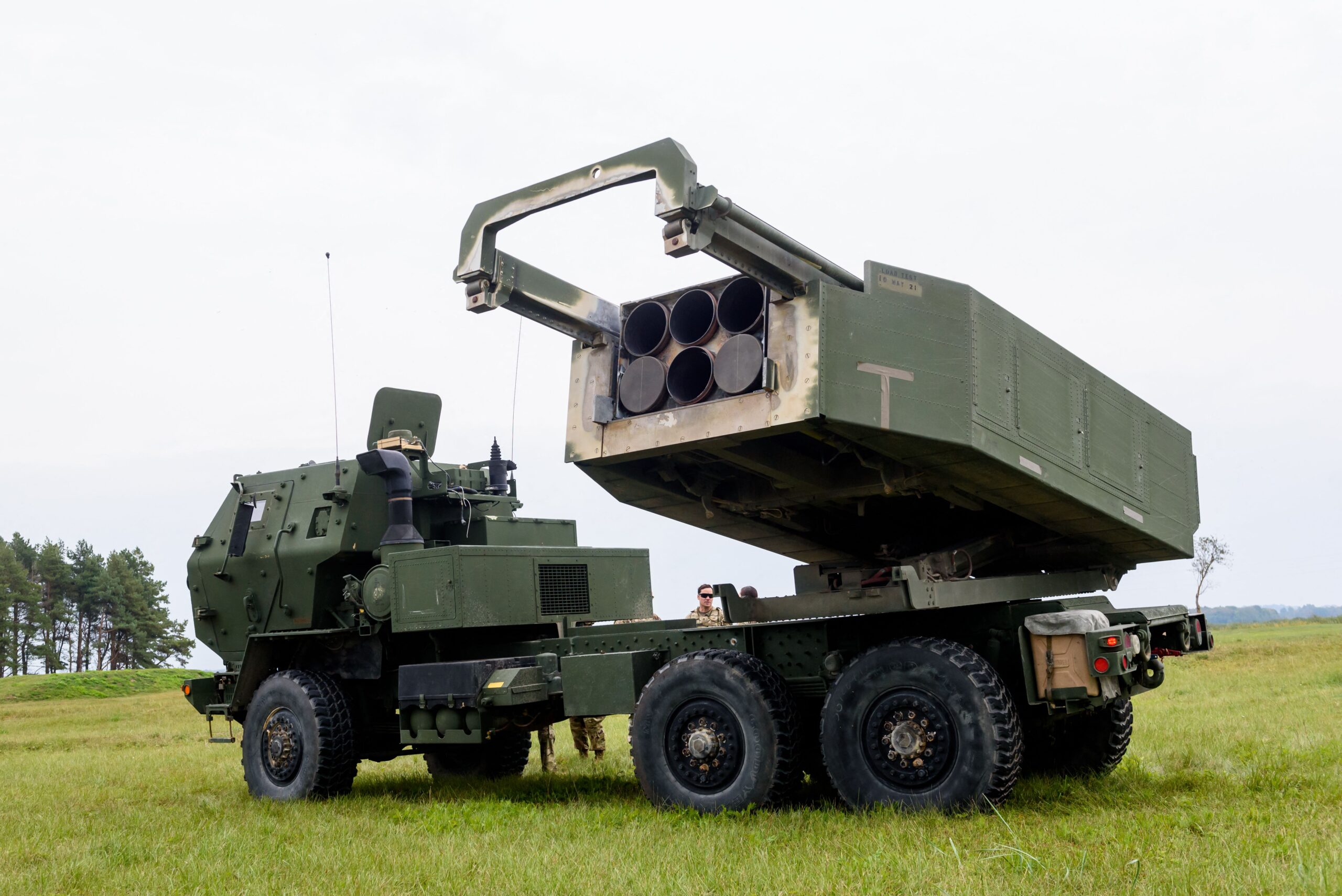The U.S.-provided M142 High Mobility Artillery Rocket Systems, or HIMARS have already made a huge difference for Ukraine and now the Pentagon is considering making them even more lethal.
The U.S. Army Contracting Command (ACC) at the Aberdeen Proving Ground last month put out a ‘Sources Sought’ notification for possible future delivery of International Field Artillery Tactical Data Systems (IFATDS) to Ukraine, as well as Taiwan and Latvia. The international export version of the Army’s Advanced Field Artillery Tactical Data System (AFATDS), IFATDS would increase HIMARS lethality by providing a secure communications system stitching together incoming information from various sources across the battlefield for a better common operating picture and greater situational awareness. This would give HIMARS operators a much better idea of where to fire the Guided Multiple Launch Rocket System (GMLRS) munitions that have already been used to devastating effect by Ukraine.

AFATDS is an automated fire-support command, control, and communications system. It provides automatic processing of fire requests and munition updates, generates multiple tactical fire mission solutions, monitors mission execution and supports, creates, and distributes fire plans.
“IFATDS will give the operator the ability to have increased situational awareness in near real-time with one common operating system that can integrate with other systems like air-missile defense, counter unmanned aerial systems, intelligence etc,” Tony Lugo, a retired Army colonel who served as Chief of Staff of the Fires Center of Excellence at Fort Sill, Oklahoma, told The War Zone Wednesday. “I believe another consideration for fielding IFATDS is the ability to link in with our AFATDs or other countries that have IFATDS. Interoperability is a key component of the new technology the military is producing. It has to be able to link into our partners’ systems.”
The system “would increase the speed of operation and increase efficiency” of the kill chain, Connor Crehan, a former Army artillery captain told The War Zone.
As a package, IFATDS would provide users “with a secure, interconnected and integrated comms package that provides better, faster use on intel and integrated fire so they can respond to threats, save ammo, plan better and operate more efficiently,” Johnna Holeman, a former Army artillery lieutenant, told The War Zone.
The ACC request is seeking up to 18 IFATDS for Ukraine, up to 16 for Taiwan, which is expecting its first HIMARS shipments in 2027, and up to 55 for Latvia, which is planning to buy six HIMARS, according to Public Broadcasting of Latvia.

This is not a request for proposals. ACC is merely looking to determine what companies can provide it with IFATDS hardware, software and associated Ultralink tactical modems, as well as classroom and field training, installation fielding support, post-deployment software support and one year of in-country field service support.
“The purpose of this market research/sources sought is to identify interested sources that are certified and able to provide requirements to Taiwan/Latvia/Ukraine,” the Sources Sought notification indicated, which had a Dec. 2 deadline for submissions.
It is unclear how many if any such submissions were received by ACC.
We reached out to ACC for more details and will update this story with any information it provides.
If the Army is given the go-ahead to provide those systems to Ukraine, it will make a very powerful, and even more fearsome, weapon. The systems would also take better advantage of other new weapons and sensors Ukraine is getting from its allies. This would be especially true during dynamic operations with rapidly changing circumstances where targets of opportunity are prevalent. But we are still far off from such a system changing things on the battlefield, given that no contracts have even been awarded yet.
Before we go into the latest news from Ukraine, The War Zone readers can get caught up on our previous rolling coverage here.
The Latest
As has been the case for a while, there has been very little movement across the battlefield, where the fiercest fighting continues to take place in Donetsk Oblast. Ukraine appears to be making advances toward Kreminna in Luhansk Oblast, while Russia digs in across the south.
Even the Russian Wargonzo Telegram channel offers a dim view of Russia’s ongoing efforts to take Bakhmut.
“On the eastern outskirts of Bakhmut itself, PMC Wagner is no longer doing very well,” according to Wargonzo. “Apparently, they decided to change the unsuccessful frontal attacks to the flank coverage of the city. But to the southeast of Soledar, everything is the same. An attempt [was made] to push through the garrison of the Armed Forces of Ukraine in Bakhmutsky from the north. The Ukrainian army in this area unexpectedly counterattacked in the direction of Stryapovka.”
Here are some key takeaways from the latest Institute for the Study of War assessment:
- Ukrainian forces have likely made more gains in northeast Ukraine than ISW has previously assessed.
- Russian forces may be nearing culmination in the Bakhmut area amid continuing Russian offensive operations there and in the Avdiivka-Donetsk City area.
- Russian forces are maintaining their fortification efforts in southern Ukraine.
- The Kremlin is continuing its efforts to publicly punish deserters and saboteurs.
While Russia appears to be building out new fortifications, that is nothing new in Ukraine, especially in the east, which has been experiencing war since Russia first invaded in 2014.
The Washington Post took a deep dive into the ongoing destruction in the Donbas, where battles have been raging since 2014.
“This destructive, and seemingly pointless, cycle of conquest and liberation has been underway for nearly nine years — ever since the Kremlin began fomenting a separatist war with false claims that Russian-speaking Ukrainians were under threat from the pro-Western, pro-democracy protesters who rose up in fury after President Viktor Yanukovych, under pressure from Putin, broke a promise to sign expansive political and economic agreements with the European Union,” the Post reported.
The Biden administration is pushing to end Iran’s ability to produce and deliver drones to Russia for use in the war in Ukraine, The New York Times reported Wednesday.
“In interviews in the United States, Europe and the Middle East, a range of intelligence, military and national security officials have described an expanding U.S. program that aims to choke off Iran’s ability to manufacture the drones, make it harder for the Russians to launch the unmanned “kamikaze” aircraft and — if all else fails — to provide the Ukrainians with the defenses necessary to shoot them out of the sky.”
Ukraine, meanwhile, is seeking to develop a fleet of drones that can attack other drones.
Ukraine “has bought some 1,400 drones, mostly for reconnaissance, and plans to develop combat models that can attack the exploding drones Russia has used during its invasion of the country, according to the Ukrainian government minister in charge of technology,” The Associated Press reported Wednesday. This is not a new idea in any way. We have been proposing it for years. In fact, the U.S. military is now acquiring this capability and fielding it in multiple forms. It could potentially provide it to Ukraine, as well.
In a recent interview with the AP, Minister of Digital Transformation Mykhailo Fedorov described Russia’s war in Ukraine as the first major war of the internet age. He credited drones and satellite internet systems like Elon Musk’s Starlink with having transformed the conflict.
“And the next stage, now that we are more or less equipped with reconnaissance drones, is strike drones,” Fedorov said. “These are both exploding drones and drones that fly up to three to 10 kilometers and hit targets.”
A week after Ukrainian President Volodymyr Zelensky visited Bakhmut, Maj. Gen. Kyrylo Budanov, head of that nation’s Defense Intelligence Directorate, made the dangerous trek to that embattled frontline city.
The Russian Fighter Bomber Telegram channel is not happy that the U.S. is potentially about to get a good look at Russia’s Ka-52 “Alligator” attack helicopter. It suggested two reasons why at least one of those helicopters was captured by Ukraine, which the country is now shipping to the U.S.
The first was the possible “unwillingness to take responsibility for the destruction of expensive equipment by all categories of commanders.” The second was failing to “let the crew repair it” or “let the paratroopers blow it up.”
Either way, Fighter Bomber downplayed the capture, saying “on the scale of ongoing historical events, these are, by and large, annoying and unpleasant little things that do not affect our victory in any way.”
Long before the full-scale invasion broke out, Ukraine and the U.S. had a very close relationship when it came to so-called foreign materiel exploitation (FME) activities, with Ukraine supplying Soviet-era hardware to the U.S. for testing, research, and training purposes. It is a given that the many losses of Russia’s most sensitive weapons on the battlefield in the last 10 months have been shared directly with Ukraine’s American allies.
Delivering rapid fires before the enemy can strike back has been critical for both sides in this conflict. Watch this Ukrainian artillery crew quickly fire and reload a French-donated CAESAR wheeled, self-propelled howitzer.
In devastated Bakhmut, Ukrainian soldiers are seen expressing confidence despite ongoing attacks. As they talk, the sounds of gunfire can be heard.
Ukrainian tanks are seen in this video driving through the streets of Bakhmut.
There’s a good reason why armies employ armor vehicles to support infantry. A great example of that can be seen in this video of Ukrainian troops evacuating under Russian fire toward the relative safety of one such vehicle.
Another compilation of Ukrainians destroying Russian tanks and troops has emerged on social media.
While Ukraine is destroying Russian armor with drones and long-range fires, it is also destroying armor at much closer ranges, as you can see in this video below.
Ukraine is also taking losses as well, like this ammunition supply truck, which apparently exploded after taking a direct hit from Russian artillery.
Video emerged of a Russian quadcopter drone dropping a VOG-17 grenade on Ukrainian soldiers trying to evacuate the wounded.
Not all the equipment donated to Ukraine manages to stay on the battlefield, as in the case of this Finnish-donated Sisu XA-185 armored amphibious personnel carrier, destroyed by Russians in Donetsk Oblast.
As it continues to suffer battlefield defeats and losses of troops and equipment, Russia is looking to increase its flow of forces by raising the draft age to 30.
As an added bonus, Russia is apparently also allowing troops headed to Ukraine to freeze their sperm for free.
“The RF Ministry of Health has decided it is possible to use money from the federal budget to fund the fee-free conservation and storage of sex cells (sperm) for citizens mobilized into the Special Military Operation, in 2022-2024,” according to CNN, citing the official Russian TASS news agency. “Any subsequent free use of conserved genetic material in assisted reproductive technology is governed by the law, provided it is indicated as a part of (the individual’s) mandatory health insurance package.”
And finally, it appears one Ukrainian unit has adopted a rather unusual pet.
That’s it for now. We will update this story when there is anything major to add.
Contact the author: howard@thewarzone.com
